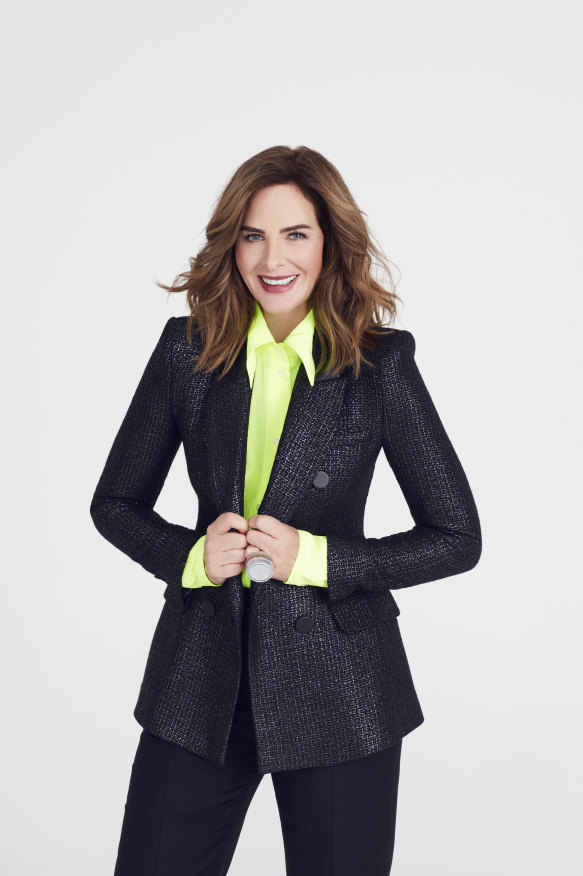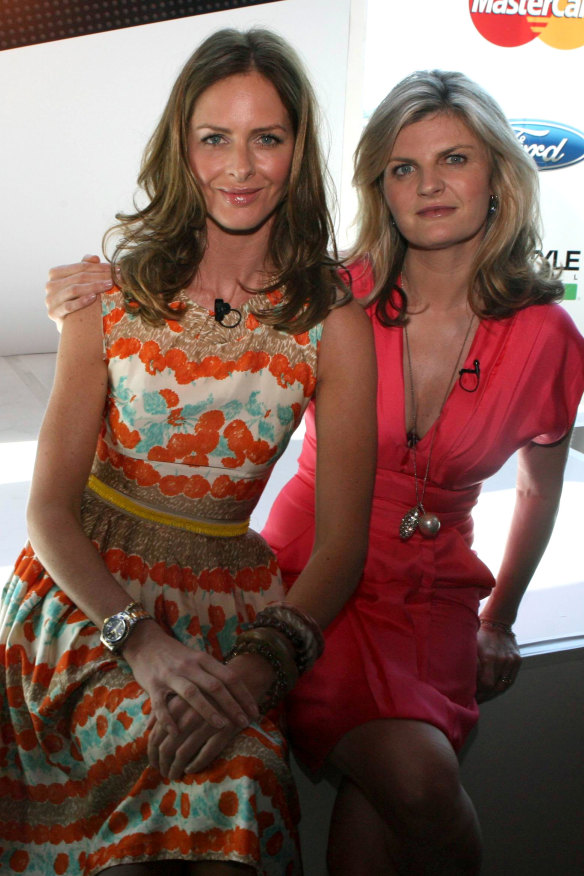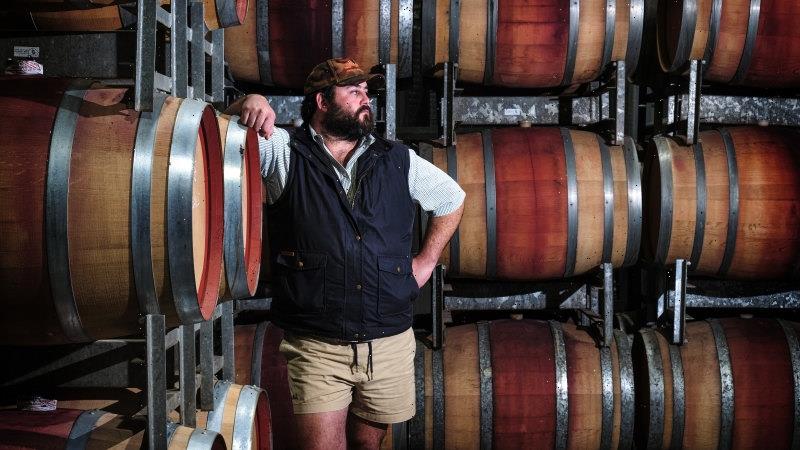By Laura Craik
“I’ve changed over the years,” says Trinny Wodall. “When I was younger, I was more insecure. When I was at my most insecure, people would feel I could be cold.”Credit:Anna Mårtensson/Headpress
There is something of the Disney princess about Trinny Woodall as she strides towards me in the shiny Chelsea HQ of Trinny London, her beauty empire that in five scant years has gone from struggling to find investors to being valued at £180 million [$300 million]. Like Belle, she is clad in yellow. Like Rapunzel, she has really good hair. Like Snow White, she has lips as red as a rose.
Unlike those hapless three, she doesn’t need to be rescued. For Trinny is her own heroine, and the skilled author of her own fairy tale. Back off, Prince Charming. You’ll ruin her lipstick.
Today, the woman who first found fame in the early 2000s co-hosting the makeover show What Not to Wear is wearing a lipstick hue called Rossy, a poppy-red from her Lip2Cheek range.
Launched in 2017, Trinny London’s success is down to an alchemical mix of clever products and innovative tech, all driven by its charismatic founder, whose enthusiastic social media presence (almost two million Facebook followers, one million Instagram followers and 338,000 subscribers on YouTube) is a powerful driver of sales. Her core customer is the midlife woman whose life is beginning to show on her face.
Trinny eschews using models on her website in favour of featuring “real” women aged from their 40s to their 80s. Her fans, known as Trinny’s Tribe, lap up her honesty and love that she’ll talk as openly about her bowel movements as she will about her blusher. One commented: “Her clothes are outright strange, her fillers are borderline frightening, but there’s something really likeable about her that keeps me watching.”
Settling down to talk in her office (she in canary-yellow Asos trousers and a silver Dries Van Noten vest), I start by congratulating her on the company’s recent sales figures and ask whether she was surprised by them.
“I was, because they’re not correct,” she says archly. “I’m not going to correct them, because there are certain figures which we don’t publish, but they were ambiguous. But sales did increase. They’d increased the year before, three times.”
Between March 2020 and January 2021, the brand grew by 280 per cent, delivering £44 million in gross revenue in the year to March 2021. Not bad during a pandemic.
“What helped us a lot is that women didn’t want to stop buying things. They may not have wanted to buy clothing, so they bought make-up instead.”
Lockdown might have spelt disaster for many businesses, but not Trinny’s. Her theory for this is that, with 95 per cent of sales already online, she didn’t have as far to pivot. Hers was among the first beauty brands to offer one-to-one online consultations, launching the service a mere 10 days after lockdown was announced; 3000 appointments were booked in the first 24 hours.
“What helped us a lot is that women didn’t want to stop buying things,” she says. “They may not have wanted to buy clothing, so they bought make-up instead. They became quite obsessed with developing a skincare routine, and trying new things.
“Although women were much busier during COVID, we also needed time for ourselves, because we were juggling. If you were looking after the house, working from home, and your kids weren’t at school, having that time was so very precious. You needed that time just to do something for you.”
My own theory is that Trinny is a P, or Perceiving, in the Myers-Briggs personality types; a person whose stellar communication skills were perfectly placed to profit from the pandemic. Like Joe Wicks, who also found huge success during lockdown, Trinny is a born communicator. Just as he got people fit, Trinny got them glowing. As she tells me today, “I want women to feel they’ve become ageless – that they’re feeling phwoar.”
At the start of the pandemic, her company employed 68 people; now, it employs 200. It sells 187 products in 200 countries, with a pot of its line-filling Miracle Blur primer selling every 60 seconds. Skincare was only launched in February, but already accounts for almost a third of sales; she’s confident that it will soon amount to 50 per cent of her business. “And then, at some point, we’ll bring out another vertical.” Haircare? Body care? “I can’t tell you. It will be what it will be.”
“I want women to feel they’ve become ageless – that they’re feeling phwoar,” says Woodall of her beauty brand.Credit:Anna Mårtensson/Headpress
As the company’s main shareholder, with a 42 per cent stake, what Trinny will be is even wealthier than she already is. Which must feel particularly gratifying, given how hard she initially found it to get investment. (Don’t imagine that a woman with a clever idea and decades of experience will be able to pluck freely from the money tree: in business, men and women are still judged by different standards. “So many discrepancies,” Trinny sighs. )
Undeterred, she raised £60,000 by selling off items from her own wardrobe, then hustled for another £7 million, a small but undisclosed amount of which was provided by her partner of nine years, businessman and art collector Charles Saatchi.
“I couldn’t afford to live in the house I was living in, so I rented it out and sold quite a few of my clothes. I then did a small raise, which I used for product development. When that ran out, I sold some more clothes, then sold my house because I couldn’t afford the mortgage. It did take balls – it was very scary. But I knew I had no alternative. Nobody becomes a great entrepreneur from a place of comfort.”
Asked what she’s learnt about money along the way, she replies, “I’ve learnt what you can live without. Until I was 18, I had a very nice, entitled life. Then my dad had some things that went a bit wrong. So I went and earned a salary, working a Saturday job at Partridges [delicatessen], cutting the meat. It took me a long time to figure out what I wanted to do – probably until I was 27. The years before were really difficult.”
That’s an understatement. Unlike Cinderella, Woodall’s isn’t a rags to riches tale, but a riches to rags to riches one. Born Sarah-Jane Woodall (the “Trinny” nickname came from a friend who likened her to a St Trinian’s character) in London, her father was a banker, her mother Ann his second wife. The youngest of three children (with three half-siblings from her father’s first marriage), she was sent to boarding school aged six.
“It did take balls – it was very scary. But I knew I had no alternative. Nobody becomes a great entrepreneur from a place of comfort.”
At 16, she started experimenting with drugs, with alcohol becoming an addiction in her 20s. Stints in rehab followed until, at 26, having lost close friends to alcoholism, she reached rock bottom and sought treatment for a final time. She has been sober for 32 years.
Her next brush with dependency came by proxy, after her marriage to property developer Johnny Elichaoff in 1999. Their 10 years together were marred by his addiction to painkillers, acquired after a motorbike accident in 2006. Trinny went through 16 rounds of IVF and several miscarriages before their daughter, Lyla, was born in 2003.
The pair split in 2009, co-parenting amicably until 2014, when Elichaoff
fell to his death from the roof of a shopping centre in London, having lost all his assets due to a string of failed investments. Creditors launched legal action against Trinny, seeking repayment of his debts, despite them having being accrued after their divorce. The case was dismissed in late 2016.
Trinny is incredibly close to Lyla, now a cheerful 18-year-old who plans to take a year out before studying film at a university in New York. “She got a scholarship,” says Trinny proudly.
At the weekend, the pair attended a bat mitzvah together, giving Trinny a rare opportunity to dance with Lyla. “That made me happy. There was one guy there, dancing with his three daughters. Those are the moments when I wish Lyla still had a dad. All these people came up and said, ‘You’ve brought up such a nice daughter,’ and I was so proud. Lyla can be very kind.”
She can also be very covetous of her mother’s wardrobe. “She sniffs around. She helped herself to my Gabriela Hearst jacket the other day. Lyla has a very eclectic style. I love it.”
The biggest challenge of raising a teenager is, she says, “doing it without her father. Not having the other person in the room to say what I should do.”
Though Lyla has a half-brother, Zak, 27, Trinny says that not having siblings is the reason she sent her to boarding school. “Hardest decision. But she still feels centred with my life because there’s only her in it. She knows I’d drop everything for her.”
She does worry about passing on the genes that made her and Elichaoff prone to addiction, but adds, “I think the most important thing that you can give a child is a sense of confidence. So whatever path she chooses to take in her life, she’s not taking it from fear. It’s important to make them feel seen, loved, everything. Flaws and all.”
Successful as she’s been, it wasn’t until her 50s that Trinny came to love her own flaws. “When you reach 50, you don’t care. You don’t worry what people think about you, and that gives you a great freedom to say what you feel. Now, what you see is what you get.”
When I tell her she is charismatic, she looks sceptical. “I’ve changed over the years. When I was younger, I was more insecure. When I was at my most insecure, people would feel I could be cold. Even today, if I’m invited to a party, I’ll spend a bit of time in the loo if I don’t know anyone there.”
Woodall with What Not to Wear co-host Susannah Constantine. “While working on What Not to Wear, I learnt to be one version of myself,” she says.Credit:Edwina Pickles
Trinny, an introvert? “I did that all the time,” she insists. “I’d not know how to talk to people. While working on What Not to Wear, I learnt to be one version of myself. I found out who I was when I stopped working with Susannah [Constantine, her co-presenter].
“She was always really funny, warm and heartfelt, so I dialled those qualities down. Susannah was chaotic when it came to running our business, whereas that’s always what I’ve done. So when we parted, she learnt to be financially independent in terms of growing her career and thinking strategically. And I learnt that I could be funny.”
She can also be blunt, but that’s part of her appeal, especially in the beauty industry. Her candour about her life is equally compelling on social media. “Having done telly, it’s easier,” she says of her natural ability in front of the camera. “If I’m feeling flat and blue, I’ll share it, because I know other people feel the same.
“It’s important that you never just see the shiny side of the coin.”
“It’s important that you never just see the shiny side of the coin. But that crossover between what’s my personal life and what’s a story worth sharing is the hardest bit for me to navigate.
“I don’t show my home – it’s somebody else’s home. But I do show my wardrobe. I do show myself doing yoga. I don’t share at all about my relationship. I share a bit about Lyla when she’s up for it. But it is difficult to switch off.”
She went into menopause 15 years ago, at 43. “Perimenopause is really unsettling. Your mojo goes a bit. Oestrogen and progesterone affect so many things. I went to a doctor and they didn’t even do any blood work – they just put me on the mare’s urine.” The what? “It’s what I call the original HRT, because one drug [Premarin] was made using the urine of a mare.”
What Not to Wear’s tagline was “We’ll tell you what your best friend won’t”, and I’m about to find out how blunt Trinny can be. She’s been itching to do a makeover since I arrived, and starts grabbing some of the many products stacked around her office.
Trinny’s own skin is incredible. A Botox devotee since the age of 35, with the exception of her lips, which are huge, I’m surprised to note that she doesn’t look “done”. At 58, she’s unimpeachably the best advertisement for her own brand. As she daubs my face, she talks about AHA, BFF, SPF, CO2 and how she’s going to Korea to learn more about peptides.
“When you go into perimenopause, you lose collagen more rapidly,” she says, applying an unguent that smells of mint. “So your skin feels thinner, you feel slack and you look tired. I don’t want to look tired.”
I assure her she doesn’t. But then, it must cost a lot to look this youthful. “If you’re feeling poor, slap your face and do A-E-I-O-Us. My grandmother taught me that classic.
“Stand up, do it,” she commands.
We stand side by side, looking in the mirror. “Say every vowel 10 times: A-A-A-A-A-A-A-A-A-A,” she intones, exaggerating each enunciation. “That tightens your jaw.”
By the time she’s saying her O’s, she sounds like Meg Ryan faking an orgasm in When Harry Met Sally. “Tiring, isn’t it?” she trills. “Tomorrow morning your facial muscles will ache. All right, last question. Come on.”
What advice would she give her 18-year-old self? “Oh, you can think of a better question than that, darling.”
I suggest she asks herself a last question – anything she likes.
“I don’t know,” she says.
She keeps talking, reeling off advice, encouraging me to “rethink my routine” just as her brand has prompted millions of others to do. I never do get to ask her a last question. But I do go home and rethink my beauty routine.
Lifeline: 13 11 14
The Telegraph, London
Make the most of your health, relationships, fitness and nutrition with our Live Well newsletter. Get it in your inbox every Monday.
Most Viewed in Lifestyle
Source: Read Full Article





